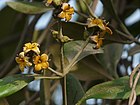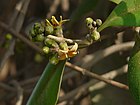Note: This is a project under development. The articles on this wiki are just being initiated and broadly incomplete. You can Help creating new pages.
Avicennia officinalis - Indian Mangrove
Indian mangrove is an evergreen shrub or tree. It is grows upto 8 - 18 metres tall but exceptionally to 25 metres tall.
Contents
[hide]- 1 Uses
- 2 Parts Used
- 3 Chemical Composition
- 4 Common names
- 5 Properties
- 6 Habit
- 7 Identification
- 8 List of Ayurvedic medicine in which the herb is used
- 9 Where to get the saplings
- 10 Mode of Propagation
- 11 How to plant/cultivate
- 12 Commonly seen growing in areas
- 13 Photo Gallery
- 14 References
- 15 External Links
Uses
Boils, Tumours, Smallpox sores, Abscesses, Skin afflictions, Scabies, Snakebite.
Parts Used
Chemical Composition
The genus includes true mangrove plants that have been reported to contain iridoids glycosides, flavonoids, diterpenes, triterpenes, fatty acids, and naphthoquinones.[1]
Common names
| Language | Common name |
|---|---|
| Kannada | ಕಾಂದಲೆ Kandale, ಮದ Mada |
| Hindi | NA |
| Malayalam | Orayi, Uppatti |
| Tamil | Venkantal |
| Telugu | Tella mada |
| Marathi | Tavir, Tivar |
| Gujarathi | Cheriyan, Ikal |
| Punjabi | NA |
| Kashmiri | NA |
| Sanskrit | Sagarodbhutah |
| English | Indian mangrove, white mangrove |
Properties
Reference: Dravya - Substance, Rasa - Taste, Guna - Qualities, Veerya - Potency, Vipaka - Post-digesion effect, Karma - Pharmacological activity, Prabhava - Therepeutics.
Dravya
Rasa
Guna
Veerya
Vipaka
Karma
Prabhava
Habit
Identification
Leaf
| Kind | Shape | Feature |
|---|---|---|
Flower
| Type | Size | Color and composition | Stamen | More information |
|---|---|---|---|---|
| {{{5}}} |
Fruit
| Type | Size | Mass | Appearance | Seeds | More information |
|---|---|---|---|---|---|
Other features
List of Ayurvedic medicine in which the herb is used
Where to get the saplings
Mode of Propagation
How to plant/cultivate
A plant of the moist to wet tropics and subtropics, where it is always found at around sea-level near the coast.[4]
Commonly seen growing in areas
Coastal marshes, Brackish silts, Saline silts.
Photo Gallery
References
External Links
- Pages using duplicate arguments in template calls
- Ayurvedic Herbs known to be helpful to treat Boils
- Ayurvedic Herbs known to be helpful to treat Tumours
- Ayurvedic Herbs known to be helpful to treat Smallpox sores
- Ayurvedic Herbs known to be helpful to treat Abscesses
- Ayurvedic Herbs known to be helpful to treat Skin afflictions
- Ayurvedic Herbs known to be helpful to treat Scabies
- Ayurvedic Herbs known to be helpful to treat Snakebite
- Herbs with Fruits used in medicine
- Herbs with Seeds used in medicine
- Herbs with common name in Kannada
- Herbs with common name in Malayalam
- Herbs with common name in Tamil
- Herbs with common name in Telugu
- Herbs with common name in Marathi
- Herbs with common name in Gujarathi
- Herbs with common name in Sanskrit
- Herbs with common name in English
- Habit - Evergreen tree
- Index of Plants which can be propagated by Seeds
- Herbs that are commonly seen in the region of Coastal marshes
- Herbs that are commonly seen in the region of Brackish silts
- Herbs that are commonly seen in the region of Saline silts
- Herbs
- Pages without herbs images





